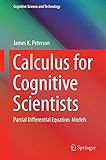Calculus for Cognitive Scientists [electronic resource] : Partial Differential Equation Models / by James K. Peterson.
By: Peterson, James K [author.].
Contributor(s): SpringerLink (Online service).
Material type: BookSeries: Cognitive Science and Technology: Publisher: Singapore : Springer Singapore : Imprint: Springer, 2016Edition: 1st ed. 2016.Description: XXXI, 534 p. 156 illus. in color. online resource.Content type: text Media type: computer Carrier type: online resourceISBN: 9789812878809.Subject(s): Engineering | Artificial intelligence | Computer graphics | Neural networks (Computer science) | Physics | Computational intelligence | Engineering | Computational Intelligence | Theoretical, Mathematical and Computational Physics | Mathematical Models of Cognitive Processes and Neural Networks | Artificial Intelligence (incl. Robotics) | Computer Imaging, Vision, Pattern Recognition and GraphicsAdditional physical formats: Printed edition:: No titleDDC classification: 006.3 Online resources: Click here to access online
BookSeries: Cognitive Science and Technology: Publisher: Singapore : Springer Singapore : Imprint: Springer, 2016Edition: 1st ed. 2016.Description: XXXI, 534 p. 156 illus. in color. online resource.Content type: text Media type: computer Carrier type: online resourceISBN: 9789812878809.Subject(s): Engineering | Artificial intelligence | Computer graphics | Neural networks (Computer science) | Physics | Computational intelligence | Engineering | Computational Intelligence | Theoretical, Mathematical and Computational Physics | Mathematical Models of Cognitive Processes and Neural Networks | Artificial Intelligence (incl. Robotics) | Computer Imaging, Vision, Pattern Recognition and GraphicsAdditional physical formats: Printed edition:: No titleDDC classification: 006.3 Online resources: Click here to access online Introduction -- Graham - Schmidt Orthogonalization -- Numerical Differential Equations -- Biological Molecules -- Ion Movement -- Lumped and Distributed Cell Models -- Time Independent Solutions to Infinite Cables -- Time Independent Solutions to Finite and Half-Infinite Space Cables -- A Primer On Series Solutions -- Linear Partial Differential Equations -- Simplified Dendrite - Soma - Axon Information Processing -- The Basic Hodgkin - Huxley Model -- Final Thoughts -- Background Reading.
This book shows cognitive scientists in training how mathematics, computer science and science can be usefully and seamlessly intertwined. It is a follow-up to the first two volumes on mathematics for cognitive scientists, and includes the mathematics and computational tools needed to understand how to compute the terms in the Fourier series expansions that solve the cable equation. The latter is derived from first principles by going back to cellular biology and the relevant biophysics. A detailed discussion of ion movement through cellular membranes, and an explanation of how the equations that govern such ion movement leading to the standard transient cable equation are included. There are also solutions for the cable model using separation of variables, as well an explanation of why Fourier series converge and a description of the implementation of MatLab tools to compute the solutions. Finally, the standard Hodgkin - Huxley model is developed for an excitable neuron and is solved using MatLab.


There are no comments for this item.